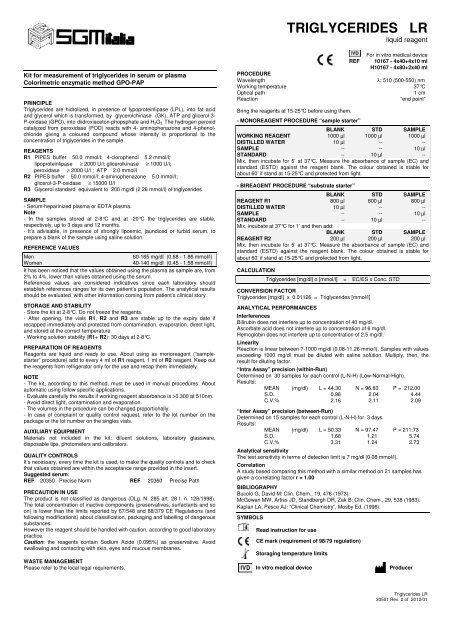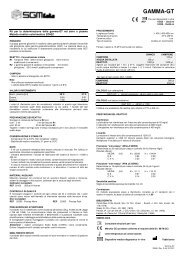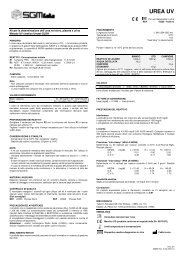TRIGLYCERIDES LR - Sgmitalia.com
TRIGLYCERIDES LR - Sgmitalia.com
TRIGLYCERIDES LR - Sgmitalia.com
Create successful ePaper yourself
Turn your PDF publications into a flip-book with our unique Google optimized e-Paper software.
Kit for measurement of triglycerides in serum or plasma<br />
Colorimetric enzymatic method GPO-PAP<br />
PRINCIPLE<br />
Triglycerides are hidrolized, in presence of lypoproteinlipase (LPL), into fat acid<br />
and glycerol which is transformed, by glycerolchinase (GK), ATP and glicerol-3-<br />
P-oxidase (GPO), into diidroxiaceton-phopsphate and H2O2. The hydrogen peroxid<br />
catalyzed from peroxidase (POD) reacts with 4- aminophenazone and 4-phenolchloride<br />
giving a coloured <strong>com</strong>pound whose intensity is proportional to the<br />
concentration of triglycerides in the sample.<br />
REAGENTS<br />
R1 PIPES buffer 50.0 mmol/l; 4-clorophenol 5.2 mmol/l;<br />
lipoproteinlipase ≥ 2000 U/l; glicerolkinase ≥ 1000 U/l;<br />
peroxidase ≥ 2000 U/l ; ATP 2.0 mmol/l<br />
R2 PIPES buffer 50.0 mmol/l; 4-aminophenazone 5.0 mmol/l;<br />
glicerol-3-P-oxidase ≥ 15000 U/l<br />
R3 Glycerol standard equivalent to 200 mg/dl (2.26 mmol/l) of triglycerides<br />
SAMPLE<br />
- Serum-heparinized plasma or EDTA plasma.<br />
Note<br />
- In the samples stored at 2-8°C and at -20°C the triglycerides are stable,<br />
respectively, up to 3 days and 12 months.<br />
- It’s advisable, in presence of strongly lipoemic, jaundiced or turbid serum, to<br />
prepare a blank of the sample using saline solution.<br />
REFERENCE VALUES<br />
Men 60-165 mg/dl (0.68 - 1.86 mmol/l)<br />
Women 40-140 mg/dl (0.45 - 1.58 mmol/l)<br />
It has been noticed that the values obtained using the plasma as sample are, from<br />
2% to 4%, lower than values obtained using the serum.<br />
References values are considered indicatives since each laboratory should<br />
establish references ranges for its own patient’s population. The analytical results<br />
should be evaluated with other information <strong>com</strong>ing from patient’s clinical story.<br />
STORAGE AND STABILITY<br />
- Store the kit at 2-8°C. Do not freeze the reagents.<br />
- After opening, the vials R1, R2 and R3 are stable up to the expiry date if<br />
recapped immediately and protected from contamination, evaporation, direct light,<br />
and stored at the correct temperature.<br />
- Working solution stability (R1+ R2): 30 days at 2-8°C.<br />
PREPARATION OF REAGENTS<br />
Reagents are liquid and ready to use. About using as monoreagent (“samplestarter”<br />
procedure) add to every 4 ml of R1 reagent, 1 ml of R2 reagent. Keep out<br />
the reagents from refrigerator only for the use and recap them immediately.<br />
NOTE<br />
- The kit, according to this method, must be used in manual procedures. About<br />
automatic using follow specific applications.<br />
- Evaluate carefully the results if working reagent absorbance is >0.300 at 510nm.<br />
- Avoid direct light, contamination and evaporation.<br />
- The volumes in the procedure can be changed proportionally.<br />
- In case of <strong>com</strong>plaint or quality control request, refer to the lot number on the<br />
package or the lot number on the singles vials.<br />
AUXILIARY EQUIPMENT<br />
Materials not included in the kit: diluent solutions, laboratory glassware,<br />
disposable tips, photometers and calibrators.<br />
QUALITY CONTROLS<br />
It’s necessary, every time the kit is used, to make the quality controls and to check<br />
that values obtained are within the acceptance range provided in the insert.<br />
Suggested serum:<br />
REF 20350 Precise Norm REF 20360 Precise Path<br />
PRECAUTION IN USE<br />
The product is not classified as dangerous (DLg. N. 285 art. 28 l. n. 128/1998).<br />
The total concentration of inactive <strong>com</strong>ponents (preservatives, surfactants and so<br />
on) is lower than the limits reported by 67/548 and 88/379 CE Regulations (and<br />
following modifications) about classification, packaging and labelling of dangerous<br />
substances.<br />
However the reagent should be handled with caution, according to good laboratory<br />
practice.<br />
Caution: the reagents contain Sodium Azide (0.095%) as preservative. Avoid<br />
swallowing and contacting with skin, eyes and mucous membranes.<br />
WASTE MANAGEMENT<br />
Please refer to the local legal requirements.<br />
<strong>TRIGLYCERIDES</strong> <strong>LR</strong><br />
liquid reagent<br />
For in vitro medical device<br />
REF 10167 - 4x40+4x10 ml<br />
H10167 - 4x80+2x40 ml<br />
PROCEDURE<br />
Wavelength λ: 510 (500-550) nm<br />
Working temperature 37°C<br />
Optical path 1 cm<br />
Reaction “end point”<br />
Bring the reagents at 15-25°C before using them.<br />
- MONOREAGENT PROCEDURE “sample starter”<br />
BLANK STD SAMPLE<br />
WORKING REAGENT 1000 µl 1000 µl 1000 µl<br />
DISTILLED WATER 10 µl -- --<br />
SAMPLE -- -- 10 µl<br />
STANDARD -- 10 µl --<br />
Mix, then incubate for 5’ at 37°C. Measure the absorbance of sample (EC) and<br />
standard (ESTD) against the reagent blank. The colour obtained is stable for<br />
about 60’ if stand at 15-25°C and protected from light.<br />
- BIREAGENT PROCEDURE “substrate starter”<br />
BLANK STD SAMPLE<br />
REAGENT R1 800 µl 800 µl 800 µl<br />
DISTILLED WATER 10 µl -- --<br />
SAMPLE -- -- 10 µl<br />
STANDARD -- 10 µl --<br />
Mix, incubate at 37°C for 1’ and then add:<br />
BLANK STD SAMPLE<br />
REAGENT R2 200 µl 200 µl 200 µl<br />
Mix, then incubate for 5’ at 37°C. Measure the absorbance of sample (EC) and<br />
standard (ESTD) against the reagent blank. The colour obtained is stable for<br />
about 60’ if stand at 15-25°C and protected from light.<br />
CALCULATION<br />
Triglycerides [mg/dl] o [mmol/l] = EC/ES x Conc. STD<br />
CONVERSION FACTOR<br />
Triglycerides [mg/dl] x 0.01126 = Triglycerides [mmol/l]<br />
ANALYTICAL PERFORMANCES<br />
Interferences<br />
Bilirubin does not interfere up to concentration of 40 mg/dl.<br />
Ascorbate acid does not interfere up to concentration of 6 mg/dl.<br />
Hemoglobin does not interfere up to concentration of 2.5 mg/dl.<br />
Linearity<br />
Reaction is linear between 7-1000 mg/dl (0.08-11.26 mmo/l). Samples with values<br />
exceeding 1000 mg/dl must be diluted with saline solution. Multiply, then, the<br />
result for diluting factor.<br />
“Intra Assay” precision (within-Run)<br />
Determined on 30 samples for each control (L-N-H) (Low-Normal-High).<br />
Results:<br />
MEAN (mg/dl) L = 44.30 N = 96.60 P = 212.00<br />
S.D. 0.96 2.04 4.44<br />
C.V.% 2.16 2.11 2.09<br />
“Inter Assay” precision (between-Run)<br />
Determined on 15 samples for each control (L-N-H) for 3 days.<br />
Results:<br />
MEAN (mg/dl) L = 50.33 N = 97.47 P = 211.73<br />
S.D. 1.68 1.21 5.74<br />
C.V.% 3.31 1.24 2.73<br />
Analytical sensitivity<br />
The test sensitivity in terms of detection limit is 7 mg/dl (0.08 mmol/l).<br />
Correlation<br />
A study based <strong>com</strong>paring this method with a similar method on 21 samples has<br />
given a correlating factor r = 1.00<br />
BIBLIOGRAPHY<br />
Bucolo G, David M: Clin. Chem., 19, 476 (1973).<br />
McGowan MW, Artiss JD, Standbergh DR, Zak B: Clin. Chem., 29, 538 (1983).<br />
Kaplan LA, Pesce AJ: “Clinical Chemistry”, Mosby Ed. (1996).<br />
SYMBOLS<br />
Read instruction for use<br />
CE mark (requirement of 98/79 regulation)<br />
Storaging temperature limits<br />
In vitro medical device Producer<br />
Triglycerides <strong>LR</strong><br />
30501 Rev. 2 of 2012/01
















